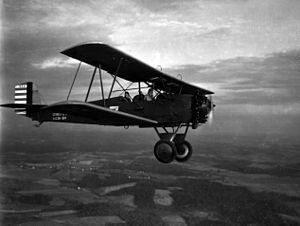- Consolidated O-17 Courier
-
O-17 Courier A Maryland National Guard Consolidated O-17 Role Observation Manufacturer Consolidated Aircraft Company First flight April 1927 Primary users United States National Guard
Royal Canadian Air ForceProduced 1928 Number built 35 Variants Consolidated PT-3 The Consolidated Model 2 Courier was an observation and training airplane used by the United States National Guard, under the designation O-17.
Contents
Development
A parallel development to the PT-3 series, the XO-17 was a converted PT-3 with such refinements as improved fuselage streamlining, oleo shock absorbers, wheel brakes, balanced elevators and increased fuel capacity.[1]
Used almost exclusively as a cross country flying, gunnery, photographic and radio trainer.[2] The O-17 had a removable fairing (carrying a Scarff ring mounting for one .30 cal (7.62 mm) trainable Browning machine gun.
The Royal Canadian Air Force purchased three generally similar aircraft, two Model 7 landplanes and one Model 8 floatplane, the latter with the same float gear as the NY series.
The sole XO-17A was converted from the PT-3 as a demonstrator that failed to secure any orders.[2] It was later fitted with the experimental Packard DR-980 Diesel engine of 225 hp (168 kW).[1]
The Model 15 was also an O-17 type airframe fitted with a Pratt & Whitney R-1340 engine. It too failed to win any contracts.[2]
Variants
- XO-17 (prototype)
- Consolidated PT-3 Conversion with a 225 hp (168 kW) Wright R-790-1 engine, streamlined fuselage, modified undercarriage, increased fuel capacity, provision for dual controls and a dorsal 0.3 in (7.62 mm) gun, one conversion.[3]
- O-17 Model 2 Courier
- Production version for United States National Guard use, 29 built.[2]
- XO-17A (prototype)
- One Consolidated PT-3 converted with a Wright R-790-3 engine intended for export.[3]
- Model 7 (RCAF landplane)
- Royal Canadian Air Force, two built.[2]
- Model 8 (RCAF floatplane)
- Royal Canadian Air Force, one built.[2]
- XPT-8 (demonstrator)
- The airframe of the XO-17A prototype fitted with a Packard DR-980 Diesel engine of 225 hp (168 kw), scrapped in 1932.[1]
- Model 15 (demonstrator)
- Conversion with a Pratt & Whitney R-1340 engine.[2]
Operators
- United States National Guard
Specifications (O-17)
Data from Eden & Moeng (2002)[2]
General characteristics
- Crew: Two
- Length: 27 ft 11 in (8.51 m)
- Wingspan: 34 ft 5.5 in (10.5 m)
- Height: 9 ft 9 in (2.97 m)
- Wing area: 296 ft2 (27.5 m2)
- Empty weight: 1,881 lb (853 kg)
- Max takeoff weight: 2,723 lb (1235 kg)
- Powerplant: 1 × Wright R-790-1 radial, 225 hp (168 kW)
Performance
- Maximum speed: 118 mph (190 km/h)
- Cruise speed: 100 mph (161 km/h)
- Range: 550 miles (885 km)
- Service ceiling: 12,000' (3660 m)
- Rate of climb: 865 ft/min (264 m/min)
Armament
- 1 × .30 cal (7.62 mm) M1919 Browning machine gun
See also
References
- ^ a b c Swanborough, F. G.; Bowers, Peter M. (1964), United States Military Aircraft Since 1909, New York: Putnam, ISBN 085177816X, http://books.google.com/books?id=3QZUAAAAMAAJ&q=O-17
- ^ a b c d e f g h Eden, Paul; Moeng, Soph (2002), The Complete Encyclopedia of World Aircraft, London: Amber Books, ISBN 9780760734322, http://books.google.com/books?id=6xMYAAAACAAJ
- ^ a b Andrade, John M. (1979), U.S. Military Aircraft Designations and Serials Since 1909, Hinckley, UK: Midland Counties Publications, ISBN 0904597229, http://books.google.co.uk/books?id=-KMgAAAAMAAJ&q=Courier
Aircraft produced by Consolidated Aircraft Manufacturer designation By role USAAC/USAAF observation aircraft Observation O-1 • O-2 • XO-3 • XO-4 • O-5 • O-6 • O-7 • O-8 • O-9 • XO-10 • O-11 • O-12 • O-14 • XO-14 • XO-15 • XO-16 • O-17 • XO-18 • O-19 • YO-20 • XO-21 • O-22 • YO-23 • O-24 • O-25 • Y1O-26 • Y1O-27 • O-28 • O-29 • O-30 • O-31 • O-32 • Y1O-33 • O-34 • O-35 • XO-36 • O-37 • O-38 • O-39 • O-40 • Y1O-41 • O-42 • O-43 • XO-44 • O-45 • O-46 • O-47 • XO-48 • O-49 • YO-50 • YO-51 • O-52 • O-53 • YO-54 • YO-55 • O-56 • O-57 • O-58 • O-59 • O-60 • XO-61 • O-62 • XO-63
Observation Amphibian USAAC/USAAF/USAF/Tri-service trainer aircraft Advanced Trainer Basic Combat Basic Trainer Primary Trainer (1924-1948) Trainer (1948-1990) "T-1", "T-2", "T-3" and "T-6" have also been assigned since 1962 in a separate sequence.Lists relating to aviation General Aircraft (manufacturers) · Aircraft engines (manufacturers) · Airlines (defunct) · Airports · Civil authorities · Museums · Registration prefixes · Rotorcraft (manufacturers) · TimelineMilitary Accidents/incidents Records Categories:- United States military reconnaissance aircraft 1930–1939
- Consolidated aircraft
- Single-engine aircraft
Wikimedia Foundation. 2010.

